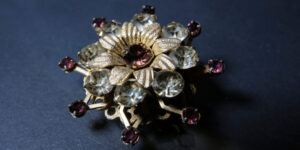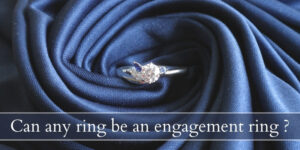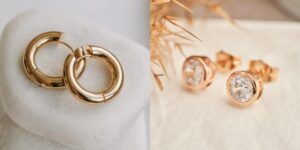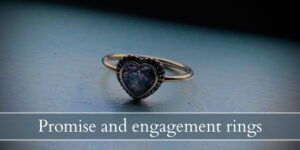Pave and solitaire engagement rings are two opposite ends of a sparkly spectrum. One focuses on a single diamond, the other focuses on the ring as a whole. Choosing your engagement ring – or one for your sweetheart – can be incredibly difficult since both have their pros and cons.
As this is a difficult decision, we’ve made this thorough comparison to get you better information. This way you can make a well informed choice, and we’ll also show you a couple of examples of pave and solitaire rings.
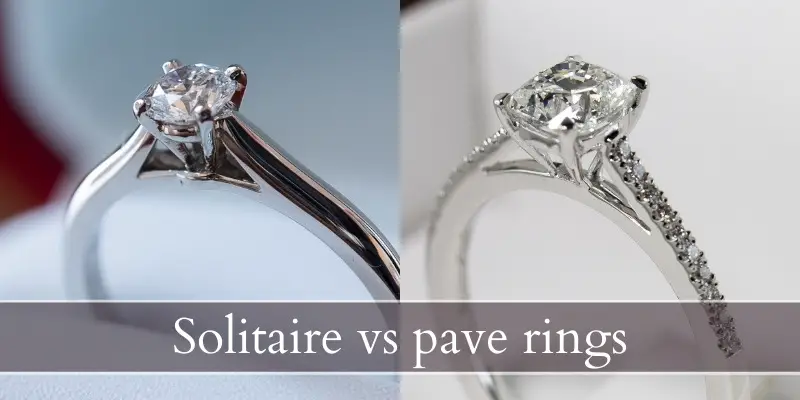
Pave vs solitaire
Pave rings offer more flash and sparkle but distract from the center stone, while solitaire rings offer a single diamond to look at and it becomes the center of attention. Due to the extra stones involved in a pave ring, this kind of setting can get quite expensive, especially if the center stone is above 1 carat.
Solitaire rings can be any carat size, but the most common are around 3ct. In these rings the metal color matters a bit more than with pave, as you see more of the band.
1. Pave settings add to the total carat weight
When buying an engagement ring you look at several factors, including total carat weight. All rings that have more than 1 diamond state their total carat weight. A pave ring will have several small diamonds, and at least 1 bigger diamond as a center stone. Or it may have a combination of stones, as a cluster setting or as a halo.
The point is that the higher the total carat weight, the higher the cost of the ring. Not all diamonds are equal, and when dealing with a row of small diamonds, they have to color match the center stone. The center stone is the most visible, which means it has to be near-perfect, and the pave around it must not stray too far in terms of color.
Meanwhile a solitaire ring focuses on a single stone, and its total carat weight may be equal to a pave ring, depending on the stones and the style. But you only have 1 diamond to worry about, which is much easier to handle if you’ve never bought diamonds before. Be sure to have that diamond appraised and certified.
2. Solitaire settings show off a single stone
Solitaire rings have a single stone, whether it’s a diamond or a gemstone. This means you can make that stone extra-special by placing a family heirloom or grandma’s diamond as a center stone. It also means that the cut, clarity, and color of the stone have to be very good, as flaws will not be hidden by other stones or a halo.
Pave rings show off different stones and the overall focus is on the ring itself, not the center stone. This gives you some room to play with the color and size of the diamonds, especially if you’re going for a specific effect, like a color or size gradient.
3. Pave settings are flashy and hard to miss
Because of the general flash, bang, and sparkle on a pave ring, it’s hard to miss compared to a solitaire. Even a pave with a 0.5 ct center stone will stand out a little more than a solitaire ring with 0.5 stone. It’s simply due to the multitude of diamonds that add extra sparkle.
If whomever is wearing the engagement ring is in love with sparkly things and showing off, a pave ring is definitely the right choice. No matter the total carat weight, it will stand out in a crowd, unless there’s a really big solitaire next to it.
Speaking of, a solitaire tends to look more sleek and elegant, some would say timeless. Some would say dull. It really depends on who is looking at the ring. A solitaire with a small diamond is simple, delicate even, and will pair greatly with someone who doesn’t want to parade their engagement ring.
Of course, you can find solitaires with big diamonds, like a 6 ct what will put any pave ring to shame. Really, it’s not all about the setting, it’s also about the diamond size.
Read also: Engagement Ring Band Width
4. Solitaire rings are easier to resize
Because solitaires are a single diamond on top of a simple bans, they are much easier to resize than a pave ring. This means the jeweler can simply cut off or add extra metal as needed to size up or down, without damaging the overall structure of the ring.
A pave ring can’t really be resized, because the diamonds on the side are encrusted into the band itself. Sizing up or down will mean damaging the structure of the ring. You’re better off buying such a ring with your fiancee-to-be and trying on several sizes. It may not be as romantic, but it’s incredibly practical.
Do pave stones fall out ?
If pave stones are poorly encrusted, they can fall out, yes. Not all paves will lose their stones, but they have a higher chance of losing a stone or two than a solitaire ring.
The reason is that the prongs holding the stones are very small, and part of the ring band itself. If you have a softer metal, like a very high carat gold, you risk the stones falling out. This is especially risky if you work with your hands a lot, and even more if you’ve got stones all around the ring, including the bottom side.
A solitaire can lose its diamond too, but the prongs are generally better made. Because the diamonds are larger, the prongs are thicker, and they hold the stone better. Always go for a 6 prong over a 4 prong if you have the chance. It provides better grip, and if one prong breaks you’ve got another 5 keeping the stone in place.
Craftsmanship is crucial for both pave and solitaire
In the end it really comes down to good or bad craftsmanship, no matter what kind of ring setting you choose. We recommend you get a good jeweler to set your diamond if you have a particular stone you like. Or if you’re buying pre-made rings, go with reputable sellers as they have a reputation to protect and can’t afford to sell faulty jewelry.
Is pave setting more expensive ?
Pave setting may end up more expensive, as the craftsmanship costs a bit more and the total carat weight of the ring may be more than a 1 ct solitaire. So not all pave rings are expensive, but they definitely have the possibility of burning a hole in your pocket.
Does pave make diamonds look bigger ?
Pave settings do not make the diamond look bigger, they distract from the center diamond, rather than make it look bigger. The only setting that makes a diamond appear larger is a halo setting, which uses a pave band all around the center diamond.
So in short no, pave settings don’t make a diamond look bigger. They do add more sparkle, so the overall look of the ring is more flashy.
Compromise: three stone settings
A satisfying compromise would be a three stone ring, rather than a solitaire or a pave. A three stone ring is the perfect cross between the two styles, as it has a center stone with two smaller ones flanking it, and it provides more sparkle than a single stone.
And it does not have diamonds going down the sides, which means you have less of a chance of losing a stone or two. You can find plenty of three stone engagement rings.
People often attach a sort of symbolism to the three stones. Here’s a few ideas you could try:
- your birth stone
- your fiancee’s birth stone
- your child’s birth stone (if any)
- your wedding month’s birth stone
- your anniversary month’s birth stone
- the couple past, present, and future
Really, the three stones could be anything, any shape, as long as you love them and you feel they fit into the overall design of the ring.

I’m the main author for jewelrymaterialguide.com. I started this site after we did tons of research before our wedding and noticed that there is information about rings, jewelry, and so on that is really hard to find on the internet.

